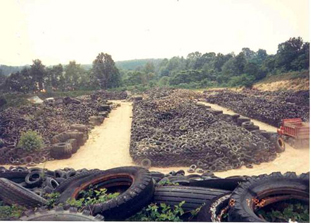Used tires: reuse, recycle, retread
 Approximately 290 million automobile and truck used tires are discarded by Americans every year.
Approximately 290 million automobile and truck used tires are discarded by Americans every year.
Since 1989, when only 10 percent of scrap tires were recycled or reused, the United States significantly increased its tire reclamation efforts to slightly more than 80 percent. However, the 55 million tires (19 percent) not reclaimed are being thrown into landfills or, even worse, disposed of illegally on roadsides and properties around the country.
Perhaps you’ve driven by a tire graveyard, where hundreds or even thousands of tires create not only an eyesore but public health and safety hazards as well. Discarded tires are convenient breeding grounds for mosquitoes and rodents, which carry a host of diseases, including West Nile virus, encephalitis, dengue fever, and hanta virus.
Tire piles attract children, who can injure themselves playing among them.Scrap tires in landfills can also damage the landfill linings that have been installed to help keep surface and groundwater free from landfill contaminants.
Another problem with discarded used tires is the risk of fire: tire pile fires can smolder for weeks and months, releasing extremely toxic pollutants into the air, creating serious respiratory and other health problems for people in the vicinity and many miles away. Runoff water from such fires are also laden with toxins, which can contaminate water supplies. In 1999, a tire fire in Westley, California, ignited by lightning, burned for 30 days. The fire produced large amounts of pyrolitic oil that not only contaminated a nearby stream but also ignited and caused additional pollution problems. In 1983, a seven-million tire fire in Rhinehart, Virginia, burned for nine months and polluted water supplies with arsenic and lead.
The good news is that 80.4 percent of scrap tires in the United States are being reclaimed in various ways. In 2003, the reclamation statistics looked like this:
- 130 million tires were used as fuel
- 56 million tires were recycled or used in civil engineering projects
- 27.5 million tires were recycled into other products or projects; for example, rubber lumber, stall mats for horses, roof pads, sports mats, shower tiles, truck bed mats, and commercial floorin
- 12 million tires were ground up and used in rubber-modified asphalt for roads and athletic tracks
- 9 million tires were sent to other countries, where they are used to make retreads (although the United States cannot guarantee they are used in this manner)
In addition to the 290 million scrap tires, 16.5 million used tires are given new temporary life as retreads. Eventually these tires will be disposed of as well.
Why not make new tires from the old? Because of safety issues, new tires must be manufactured primarily from virgin rubber, with recycled rubber making up only 5 to 15 percent of the finished product. That leaves much scrap rubber for other uses, as noted above.
There are two main ways you can help keep used tires out of the landfills: delay your need to replace your tires, and make sure your old tires are recycled properly when you do buy new ones.
How to Delay Replacement
- Keep your tires properly inflated. Check the air pressure in all tires (including your spare) when the tires are cold; do this once a month and before any long trip. The correct air pressure should be on the sticker attached to the car door, door post, fuel door, or glove box. You can also check your owner’s manual, the tire manufacturer, or a local tire dealer.
- At least once a month, inspect all your tires for signs of uneven wear, which can be an indication of improper tire inflation, improper balance, poor suspension, or misalignment.
- When checking for tire wear, also look for any glass, stones, or metal objects that may have become stuck in your tires. Deeply embedded items can cause loss of air pressure.
- Rotate your tires approximately every 6,000 miles (or sooner if there are signs of uneven wear) or as specified by the tire manufacturer.
- Drive responsibly: avoid potholes, don’t hit curbs, avoid fast starts, turns, and stops
- Read more about proper tire maintenance at the Rubber Manufacturer Association website
How to Recycle Responsibly
- Know your state’s laws concerning tire recycling. Forty-eight states have some type of regulations or laws concerning the handling of scrap tires.
- Have your tires replaced and recycled by a reputable facility. Ask the manager what they do with the used tires they collect from customers. Many states have laws that allow facilities to collect fees to pay for scrap tire management programs. These fees usually range from fifty cents to two dollars per passenger car tire or higher for truck tires.
- Support tire recycling by purchasing products made from recycled tires, such as rubber lumber products (e.g., picnic tables, benches, borders for gardens), landscape mulch, floor mats, truck bed liners, and flooring.
- Report illegal dumping of tires. Contact your area or state solid waste management office or department of environmental quality. The US Environmental Protection Agency also has a booklet, available online, about illegal tire dumping.
You can return to the main Market News page, or press the Back button on your browser.

